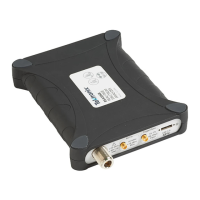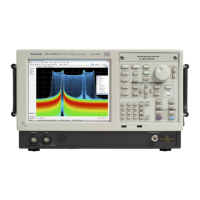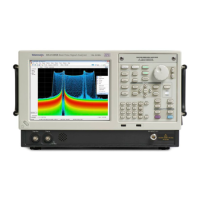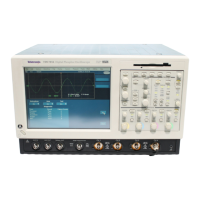Performance ver
ification
6. Set the signal generator frequency to 2785 M Hz .
7. Set the signal generator amplitude to –23 dBm.
8. Set the tunable band pass filter (K &L 5BT-1500/3000-5-N/N) near 2785 MHz.
9. Adjust the tunable filter for maximum power on the power meter.
10. Set the signal generator output to –30 dBm at the power meter. This is also the amplitude at the input of the R SA306.
The generato
r amplitude will be close to –23 dBm.
11. Measure and r
ecord the 2RF X 2LO spur amplitude for these settings. (See Table 25 on page 53.)
12. Calculate a
nd record the 2RF X 2LO spur amplitude in dBc (2RF X 2LO spur amplitude (dBm + 30).
13. Set the sign
al generator output to Off.
14. Disconnect
the tunable band pass filter and install the 3300 MHz cutoff, L250 low pass filter in its place (K&L
5L3-3300/E 10000 – O/OP).
15. Set the signal generator output to On.
16. Set the RSA306 to 2870 MHz center frequency.
17. Set the signal generator frequency to 4655 MHz.
18. Set the signal generator output to –30 dBm at the power meter. This is also the amplitude at the input of the R SA306.
The generator amplitude will be close to –23 dBm.
19. Measure and record the 2RF X 2LO spur amplitude for these settings. (See Table 25 on page 53.)
20. Calculate and record the 2 RF X 2LO spur amplitude in dBc (2RF X 2LO spur amplitude (dBm + 30).
21. Record results in the Test record.
NOTE. T
his table includes the w orst 2RF X 2LO spurs observed on the RSA306.
Table
25: 2RF X 2LO: RSA306 and signal generator frequencies
Center frequency,
MHz (RSA306)
Signal generator
frequency, MHz
2RF X 2LO spur
amplitude, dBm
2RF X 2LO spur
amplitude, dBc
1
Specification, dBc
(relative to –30 dBm
input)
2190 MHz 2785 MHz < –50 dB c
2870 MHz 4655 MHz < –50 dBc
1
2RF X 2LO spur amplitude + 30.
53 RSA306 Specifications and Performance Verification
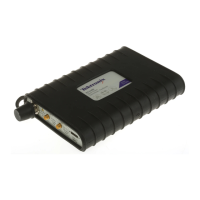
